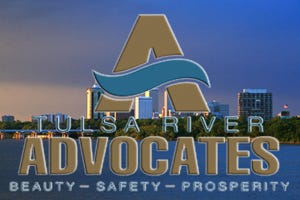Zink Dam work to begin in August
Analysis: City councilors approved a budget amendment Wednesday that transfers $6.35 million from the city’s fiscal year 2021 budget into the Zink Dam project to cover a revenue shortfall.
Now the first of three dams necessary to restore a healthy river environment can be constructed.
The daily newspaper summarizes: "The key elements of the Zink Dam reconstruction project include replacing and increasing the number of gates, from three to 15. The gates will range in height from 3 feet to 10 feet. The tallest gates in the existing dam are 7 feet high. A 1,000-foot-long flume for kayaking and other water activities will be built along the east bank of the Arkansas River south of the pedestrian bridge. And Tulsans will finally get a true Zink Lake, with water backing up to well north of the 21st Street Bridge." Click here for more from the Tulsa World.
It is a welcome story to most area residents as the previous day, July 22, the paper published a "critics only story" absent fact beyond critical opinion titled, "Waterway warriors: Zink Dam objectors fight for a 'natural' Arkansas River" click here to read that story.
Critics refuse to accept scientific facts that the Arkansas River in Tulsa County is not a "natural" river, but a hydroelectric river (Keystone and Kaw Dams). Without intervention; the 42 miles of Arkansas River in Tulsa County is currently unhealthy for fish, wildlife or humans. The river is scaring if not removing bedrock. Sand required for a "wild Prairie River" is blocked at both dams.
Keystone Dam releases water at peak times of electric usage, but that water surge arrives in Tulsa County usually near 11:00 pm and is gone by about 3:00 am each day. People have died in Tulsa County when, unaware, they slept on a river sandbar as a surge overcame them.
With all three dams in place; water released will first be stored in a Sand Springs reservoir then gradually flow downstream thus establishing a regular flow good for fish, wildlife and humans.
Sadly, some emotionally invested in "humans bad" ignore true conservation efforts like this development that assist nature to recover. The existing dams can not be removed as they also help control flooding in the area.
Funding and permitting any effort on a national river is highly regulated, lengthy and expensive but the 42 miles of Arkansas River in Tulsa County are worth it.
About the author: Publisher David Arnett won two national awards as a First Amendment Advocate. He worked as a city reporter for the former Tulsa Tribune and paid contributor to several other regional and national newspapers.
Arnett published community papers in the 80s, but operates TulsaToday.com (est. 1996) to provide a platform for diverse local news and opinion - it is the oldest online local news service in the world. He was a local call-in radio talk show host for a year, currently provides communication consulting for select clients, enjoys landscaping, brewing beer and plays guitar and percussion.








